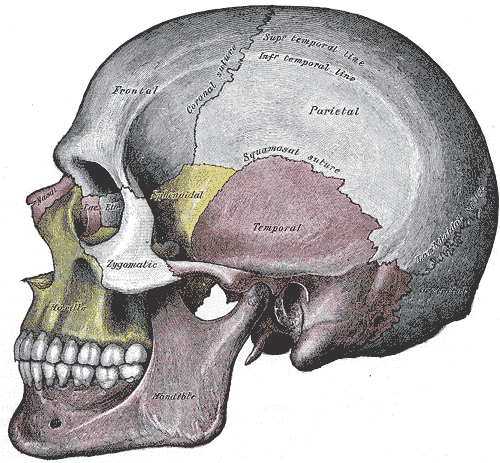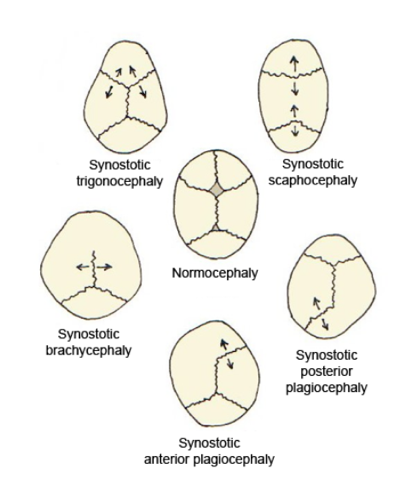|
Coronal Suture
The coronal suture is a dense, fibrous connective tissue joint that separates the two parietal bones from the frontal bone of the skull. Structure The coronal suture lies between the paired parietal bones and the frontal bone of the skull. It runs from the pterion on each side. Nerve supply The coronal suture is likely supplied by a branch of the trigeminal nerve. Development The coronal suture is derived from the paraxial mesoderm. Clinical significance If certain bones of the skull grow too fast then premature fusion of the sutures, craniosynostosis, may occur. This can result in skull deformities. These deformities include: * Brachycephaly (both sides) * Plagiocephaly (one side only) * Oxycephaly (both sides) References * "Sagittal suture." ''Stedman's Medical Dictionary, 27th ed.'' (2000). * Moore, Keith L., and T.V.N. Persaud. ''The Developing Human: Clinically Oriented Embryology, 7th ed.'' (2003). Additional images File:Coronal suture - ani ... [...More Info...] [...Related Items...] OR: [Wikipedia] [Google] [Baidu] |
Trigeminal Nerve
In neuroanatomy, the trigeminal nerve (literal translation, lit. ''triplet'' nerve), also known as the fifth cranial nerve, cranial nerve V, or simply CN V, is a cranial nerve responsible for Sense, sensation in the face and motor functions such as biting and chewing; it is the most complex of the cranial nerves. Its name (''trigeminal'', ) derives from each of the two nerves (one on each side of the pons) having three major branches: the ophthalmic nerve (V), the maxillary nerve (V), and the mandibular nerve (V). The ophthalmic and maxillary nerves are purely sensory, whereas the mandibular nerve supplies motor as well as sensory (or "cutaneous") functions. Adding to the complexity of this nerve is that Autonomic nervous system, autonomic nerve fibers as well as special sensory fibers (taste) are contained within it. The motor division of the trigeminal nerve derives from the Basal plate (neural tube), basal plate of the embryonic pons, and the sensory division originates in ... [...More Info...] [...Related Items...] OR: [Wikipedia] [Google] [Baidu] |
Paraxial Mesoderm
Paraxial mesoderm, also known as presomitic or somitic mesoderm, is the area of mesoderm in the neurulating embryo that flanks and forms simultaneously with the neural tube. The cells of this region give rise to somites, blocks of tissue running along both sides of the neural tube, which form muscle and the tissues of the back, including connective tissue and the dermis. Formation and somitogenesis The paraxial and other regions of the mesoderm are thought to be specified by bone morphogenetic proteins (BMPs) along an axis spanning from the center to the sides of the body. Members of the fibroblast growth factor family also play an important role, as does the Wnt pathway. In particular, Noggin, a downstream target of the Wnt pathway, antagonizes BMP signaling, forming boundaries where antagonists meet and limiting this signaling to a particular region of the mesoderm. Together, these pathways provide the initial specification of the paraxial mesoderm and maintain this ident ... [...More Info...] [...Related Items...] OR: [Wikipedia] [Google] [Baidu] |
Joints Of The Head And Neck
A joint or articulation (or articular surface) is the connection made between bones, ossicles, or other hard structures in the body which link an animal's skeletal system into a functional whole.Saladin, Ken. Anatomy & Physiology. 7th ed. McGraw-Hill Connect. Webp.274/ref> They are constructed to allow for different degrees and types of movement. Some joints, such as the knee, elbow, and shoulder, are self-lubricating, almost frictionless, and are able to withstand compression and maintain heavy loads while still executing smooth and precise movements. Other joints such as suture (joint), sutures between the bones of the skull permit very little movement (only during birth) in order to protect the brain and the sense organs. The connection between a tooth and the jawbone is also called a joint, and is described as a fibrous joint known as a gomphosis. Joints are classified both structurally and functionally. Joints play a vital role in the human body, contributing to movement, sta ... [...More Info...] [...Related Items...] OR: [Wikipedia] [Google] [Baidu] |
Human Head And Neck
Humans (''Homo sapiens'') or modern humans are the most common and widespread species of primate, and the last surviving species of the genus ''Homo''. They are great apes characterized by their hairlessness, bipedalism, and high intelligence. Humans have large brains, enabling more advanced cognitive skills that facilitate successful adaptation to varied environments, development of sophisticated tools, and formation of complex social structures and civilizations. Humans are highly social, with individual humans tending to belong to a multi-layered network of distinct social groups — from families and peer groups to corporations and political states. As such, social interactions between humans have established a wide variety of values, social norms, languages, and traditions (collectively termed institutions), each of which bolsters human society. Humans are also highly curious: the desire to understand and influence phenomena has motivated humanity's deve ... [...More Info...] [...Related Items...] OR: [Wikipedia] [Google] [Baidu] |
Cranial Sutures
In anatomy, fibrous joints are joints connected by Fibrous connective tissue, fibrous tissue, consisting mainly of collagen. These are fixed joints where bones are united by a layer of white fibrous tissue of varying thickness. In the skull, the joints between the bones are called Suture (anatomy), sutures. Such immovable joints are also referred to as synarthrosis, synarthroses. Types Most fibrous joints are also called "fixed" or "immovable". These joints have no joint cavity and are connected via fibrous connective tissue. * Suture (anatomy), Sutures: The skull bones are connected by fibrous joints called ''#Sutures, sutures''. In fetus, fetal skulls, the sutures are wide to allow slight movement during birth. They later become rigid (synarthrosis, synarthrodial). * Syndesmosis: Some of the long bones in the body such as the radius (bone), radius and ulna in the forearm are joined by a ''#Syndesmosis, syndesmosis'' (along the interosseous membrane of forearm, interosseous mem ... [...More Info...] [...Related Items...] OR: [Wikipedia] [Google] [Baidu] |
Frontal Bone
In the human skull, the frontal bone or sincipital bone is an unpaired bone which consists of two portions.'' Gray's Anatomy'' (1918) These are the vertically oriented squamous part, and the horizontally oriented orbital part, making up the bony part of the forehead, part of the bony orbital cavity holding the eye, and part of the bony part of the nose respectively. The name comes from the Latin word ''frons'' (meaning "forehead"). Structure The frontal bone is made up of two main parts. These are the squamous part, and the orbital part. The squamous part marks the vertical, flat, and also the biggest part, and the main region of the forehead. The orbital part is the horizontal and second biggest region of the frontal bone. It enters into the formation of the roofs of the orbital and nasal cavities. Sometimes a third part is included as the nasal part of the frontal bone, and sometimes this is included with the squamous part. The nasal part is between the brow ridges, ... [...More Info...] [...Related Items...] OR: [Wikipedia] [Google] [Baidu] |
Turricephaly
Turricephaly is a type of cephalic disorder where the head appears tall with a small length and width. It is due to premature closure of the coronal suture plus any other suture, like the lambdoid, or it may be used to describe the premature fusion of all sutures. It should be differentiated from Crouzon syndrome. Oxycephaly (or acrocephaly) is a form of turricephaly where the head is cone-shaped, and is the most severe of the craniosynostoses. Presentation Common associations It may be associated with: * 8th cranial nerve lesion * Optic nerve compression * Intellectual disability * Syndactyly Conditions with turricephaly Conditions with turricephaly include: * Achondrogenesis, type IA * Acrocephalopolydactyly * Acrocephalosyndactyly type V (Goodman syndrome) * Acrocraniofacial dysostosis * Alopecia - contractures - dwarfism - intellectual disability syndrome * CEBALID syndrome * Chromosome 1q21.1 deletion syndrome * Chromosome 4q32.1-q32.2 triplication syndrome * Chrom ... [...More Info...] [...Related Items...] OR: [Wikipedia] [Google] [Baidu] |
Plagiocephaly
Plagiocephaly, also known as flat head syndrome, is a condition characterized by an asymmetrical distortion (flattening of one side) of the skull. A mild and widespread form is characterized by a flat spot on the back or one side of the head caused by remaining in a supine position for prolonged periods. Plagiocephaly is a diagonal asymmetry across the head shape. Often it is a flattening which is to one side at the back of the head, and there is often some facial asymmetry. Depending on whether synostosis is involved, plagiocephaly divides into two groups: synostotic, with one or more fused cranial sutures, and non-synostotic (deformational). Surgical treatment of these groups includes the deference method; however, the treatment of deformational plagiocephaly is controversial. Brachycephaly describes a very wide head shape with a flattening across the whole back of the head. Causes Slight plagiocephaly is routinely diagnosed at birth and may be the result of a restrictive int ... [...More Info...] [...Related Items...] OR: [Wikipedia] [Google] [Baidu] |
Brachycephaly
Brachycephaly (derived from the Ancient Greek '' βραχύς'', 'short' and '' κεφαλή'', 'head') is the shape of a skull shorter than average in its species. It is perceived as a cosmetically desirable trait in some domesticated dog and cat breeds, notably the pug and Persian, and can be normal or abnormal in other animal species. In humans, brachycephaly can appear both pathologically and non-pathologically as a result of normal human variation. It is particularly common in Mongolians and the Andamanese. In anthropology, human populations have been characterized as either dolichocephalic (long-headed), mesocephalic (moderate-headed), or brachycephalic (short-headed). The usefulness of the cephalic index was questioned by Giuseppe Sergi, who argued that cranial morphology provided a better means to model racial ancestry. When pathological, it is known as flat head syndrome, and it results from premature fusion of the coronal sutures, or from external deformation. ... [...More Info...] [...Related Items...] OR: [Wikipedia] [Google] [Baidu] |
Craniosynostosis
Craniosynostosis is a condition in which one or more of the fibrous sutures in a young infant's skull prematurely fuses by turning into bone (ossification), thereby changing the growth pattern of the skull. Because the skull cannot expand perpendicular to the fused suture, it compensates by growing more in the direction parallel to the closed sutures. Sometimes the resulting growth pattern provides the necessary space for the growing brain, but results in an abnormal head shape and abnormal facial features. In cases in which the compensation does not effectively provide enough space for the growing brain, craniosynostosis results in increased intracranial pressure leading possibly to visual impairment, sleeping impairment, eating difficulties, or an impairment of mental development combined with a significant reduction in IQ. Craniosynostosis occurs in one in 2000 births. Craniosynostosis is part of a syndrome in 15% to 40% of affected patients, but it usually occurs as an isol ... [...More Info...] [...Related Items...] OR: [Wikipedia] [Google] [Baidu] |
Churchill Livingstone
Churchill Livingstone is an academic publisher. It was formed in 1971 from the merger of Longman's medical list, E & S Livingstone (Edinburgh, Scotland) and J & A Churchill (London, England) and was owned by Pearson. Harcourt acquired Churchill Livingstone in 1997. It is now integrated as an imprint in Elsevier's health science The following outline is provided as an overview of and topical guide to health sciences: Health sciences – those sciences that focus on health, or health care, as core parts of their subject matter. Health sciences relate to multiple ... division after Elsevier acquired Harcourt in 2001. In the past it published a number of classic medical texts, including Sir William Osler's textbook '' The Principles and Practice of Medicine, Gray's Anatomy,'' and '' Myles' Textbook for Midwives.'' In the 1980s, in addition to new texts in all areas of clinical medicine, it published an extensive list of medical and nursing textbooks in low-cost e ... [...More Info...] [...Related Items...] OR: [Wikipedia] [Google] [Baidu] |




